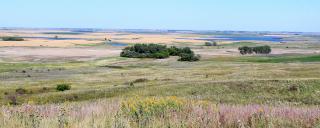
Eastern Mixed-grass Prairie (Drift Prairie)
Area: 16,900,000 acres or 26,400 mi²
Description and Overall Condition: This landscape component consists of the Eastern mixed-grass prairie, or Drift Prairie. The Drift Prairie is the transition zone between the wetter tallgrass prairie to the east and drier shortgrass prairie to the west. A high concentration of temporary and seasonal wetlands occurred within the prairie before settlement. Approximately 1.4 million wetland basin acres are present although many have been drained, filled or consolidated.
The Pembina Hills, Turtle Mountains, and Devils Lake are defining features within this region but are included under the landscape component of Upland Forest (see Figures 35, 36 and 37). A large area of untilled land due to its sandy, gravelly soil from a glacial lake delta exists in and around McHenry County and south of the Turtle Mountains. This focus area, referred to as “Glacial Lake Deltas” is to a large extent native vegetation with many wetlands remaining. In more recent years, irrigation has allowed areas once unsuitable for cropland to be farmed for potatoes and other crops. The Souris River (see Figure 32) riparian area divides the Glacial Lake Deltas. Another focus area, the “Devils Lake Basin” is the result of glacial ice blockage and includes a high concentration of larger wetlands or lakes and slightly lesser amount of grassland than the Glacial Lake Deltas. This focus area is extremely important for migrating waterfowl and other waterbirds and shorebirds. The remainder of the Drift Prairie is generally flat land, much of which has been converted to cropland of spring wheat, durum, other small grains, canola, sunflowers, and alfalfa. The Sheyenne and James rivers meander through this region.
Predominant Natural Vegetation
Grasses
prairie junegrass, green needlegrass, needle-and-thread, blue grama, little bluestem, yellow sedge, Western wheatgrass, Canada wild rye, spike oats, big sandgrass, porcupine grass, mat muhly, side-oats grama, Leiberg's panicum, needleaf sedge, threadleaf sedge
Forbs
pasque flower, Western wall-flower, torch flower, prairie rose, Missouri milkvetch, purple loco, lead plant, Indian breadroot, purple prairie-clover, gaura, hairy puccoon, harebell, stiff goldenrod, smooth fleabane, purple coneflower, upland wormwood, fringed sage
Associated Species of Conservation Priority
Birds
horned grebe, american bittern, northern pintail, lesser scaup, northern harrier, american kestrel, swainson’s hawk, ferruginous hawk, sharp-tailed grouse, yellow rail, willet, upland sandpiper, marbled godwit, wilson’s phalarope, franklin’s gull, black tern, short-eared owl, loggerhead shrike, sedge wren, sprague’s pipit, lark bunting, grasshopper sparrow, baird’s sparrow, le conte’s sparrow, nelson’s sparrow, chestnut-collared longspur, dickcissel, bobolink, western meadowlark
Mammals
pygmy shrew, arctic shrew, plains pocket mouse, richardson’s ground squirrel, gray fox
Reptiles/Amphibians
plains spadefoot, canadian toad, smooth green snake, plains hog-nosed snake
Insects
dakota skipper, monarch butterfly, regal fritillary
Other Characteristic Wildlife
Birds
American wigeon, green-winged teal, mallard, blue-winged teal, Northern shoveler, gadwall, lesser scaup, red-tailed hawk, American kestrel, gray partridge, ring-necked pheasant, spotted sandpiper, killdeer, mourning dove, common nighthawk, Western kingbird, Eastern kingbird, horned lark, American crow, Eastern bluebird, common yellowthroat, clay-colored sparrow, vesper sparrow, Savannah sparrow, Western meadowlark, brown-headed cowbird
Mammals
Northern short-tailed shrew, white-tailed jackrabbit, snowshoe hare, Franklin's ground squirrel, thirteen-lined ground squirrel, Northern pocket gopher, olive-backed pocket mouse, Western harvest mouse, deer mouse, Northern grasshopper mouse, prairie vole, meadow vole, meadow jumping mouse, Western jumping mouse, coyote, red fox, raccoon, badger, striped skunk, white-tailed deer, moose
Reptiles/Amphibians
American toad, Great Plains toad, Woodhouse's toad, Northern leopard frog, chorus frog, tiger salamander, plains garter snake, common garter snake
For more detailed information about this topic, please see the North Dakota Wildlife Action Plan.

